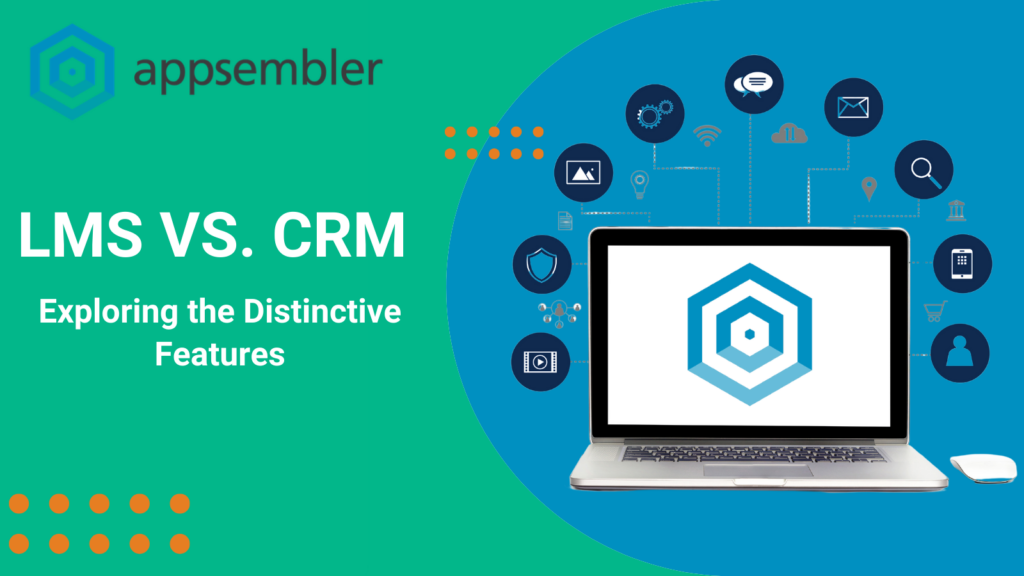In the digital landscape of business and education, understanding the distinct roles and functionalities of Learning Management Systems (LMS) and Customer Relationship Management (CRM) systems is pivotal. This article delves into the definitions, key features, and applications of LMS and CRM, compares their functionalities, and discusses the strategic importance of selecting the right system based on organizational goals and needs.
Key Takeaways
- LMS and CRM Defined: LMS focuses on managing educational content and training, while CRM is centered around managing customer relationships and data.
- Functionality Comparison: LMS enhances learning experiences, CRM optimizes customer interactions; both have unique data management and user engagement features.
- Integration Potential: LMS and CRM can be integrated for synergistic benefits in user engagement and data analytics.
- Choosing the Right System: Factors like organizational objectives, scalability, and cost should guide the selection of an LMS or CRM system.
- Strategic Importance: The choice between LMS and CRM impacts organizational efficiency, customer or learner engagement, and long-term success.
Table of Contents
Understanding LMS
LMSs have become the cornerstone of modern education and corporate training. An LMS is a software application or web-based technology used to plan, implement, and assess a specific learning process. It serves as a virtual hub where educators and trainers can create, deliver, and manage educational content and track learner engagement and performance.
The primary purpose of an LMS is to enhance the learning experience. It enables instructors to deliver customized content to learners, assess their progress, and provide immediate feedback. For learners, it offers accessibility to educational resources, flexibility in learning, and a personalized learning path tailored to their individual needs and pace.
Key features of an LMS include:
- Course Management: Allows the creation, distribution, and management of course materials, ensuring that learners have easy access to resources.
- Tracking and Reporting: Monitors learner progress and performance, providing insights into their learning curve and areas for improvement.
- Assessment and Feedback: Facilitates various forms of assessments, quizzes, and surveys, along with tools for giving and receiving feedback.
- Collaboration Tools: Offers forums, chatrooms, and social media integrations to foster interaction and collaboration among learners and instructors.
- Customization and Integration: Provides options to customize the learning experience and integrate with other tools and systems, enhancing functionality and user experience.
In educational settings, LMSs are instrumental in delivering structured courses and degree programs, supporting both teachers and students in the learning process. They enable schools and universities to expand their reach beyond traditional classrooms, offering online and blended learning opportunities.
In corporate environments, LMSs are pivotal in employee training and development. They are used for onboarding new employees, providing continuous professional development, and keeping staff updated on industry changes and company policies. This not only improves the skills and efficiency of employees but also plays a vital role in employee engagement and retention.
The versatility and scalability of LMS make it an indispensable tool in both educational and corporate settings. By providing a structured, interactive, and measurable learning environment, LMSs not only simplify the learning and teaching processes but also significantly contribute to the overall growth and development of organizations and individuals.
Understanding CRM
CRM systems are the backbone of customer-centric business strategies, focusing on optimizing customer interactions and enhancing business relationships. At its essence, CRM is a comprehensive approach to managing a company’s interactions with current and prospective customers. It leverages data and technology to improve business relationships, streamline processes, and boost profitability.
The primary purpose of CRM is to create a unified system that records and analyzes customer interactions across various channels. This consolidation of customer data into a single repository enables businesses to offer personalized experiences, anticipate customer needs, and build stronger, more meaningful relationships.
Key features of a CRM system include:
- Contact Management: Centralizes all customer information, making it easy to access and manage customer data, including contact details, communication history, and preferences.
- Sales Management: Tracks sales activities, manages leads, and streamlines the sales process, leading to increased sales efficiency and effectiveness.
- Marketing Automation: Integrates marketing processes and campaigns, targeting customers with personalized content and tracking the effectiveness of marketing efforts.
- Customer Service and Support: Facilitates efficient handling of customer inquiries and complaints, ensuring timely and effective resolution and improving customer satisfaction.
- Analytics and Reporting: Provides insights into customer behavior, sales trends, and marketing effectiveness, enabling data-driven decision-making.
In business environments, CRM applications are diverse and impactful. For sales teams, CRM is a vital tool for tracking customer interactions, managing leads, and closing deals more efficiently. Marketing departments utilize CRM to understand customer preferences and behaviors, tailoring marketing campaigns for maximum impact. For customer service, CRM is indispensable in providing quick and personalized responses to customer inquiries building trust and loyalty.
One of CRM’s foremost advantages is its ability to personalize the customer experience. By understanding individual customer needs and history, businesses can tailor their offerings, resulting in higher customer satisfaction and loyalty. CRM also enhances internal communication and coordination among different departments, fostering a unified approach to customer management.
Moreover, CRM systems are instrumental in providing valuable analytics and insights. They help businesses understand market trends, customer buying patterns, and campaign effectiveness, which are crucial for strategic planning and decision-making.
In summary, CRM is not just a technological tool; it’s a strategic framework that places the customer at the heart of a business. It empowers companies to not only understand their customers better but also to engage with them in a more meaningful, efficient, and profitable manner. As businesses increasingly recognize the value of customer relationships, CRM systems have become essential in driving business growth and success in a competitive marketplace.
Appsembler’s Role in Bridging LMS and CRM
In the dynamic landscape where LMS and CRM systems play crucial roles, Appsembler emerges as a game-changer. Appsembler’s Tahoe LMS, an innovative platform, stands at the intersection of LMS and CRM, offering solutions that harness the strengths of both systems to create a more integrated and effective user experience.
Overview of Appsembler:
Appsembler is a versatile platform that simplifies and enhances the online learning experience. It provides customizable LMS solutions with Tahoe LMS designed to be user-friendly, scalable, and highly adaptable to various organizational needs. Appsembler’s approach is grounded in providing interactive and engaging learning experiences, making it a preferred choice for educational institutions and businesses alike.
Integrating LMS and CRM Functionalities:
Appsembler uniquely positions itself by integrating key functionalities of LMS and CRM systems. It allows seamless data syncing between the two systems, enhancing utility and efficiency. For instance, the integration enables businesses to track customer training progress within the CRM, providing valuable insights into customer engagement and satisfaction.
Furthermore, Appsembler’s integration capabilities extend to personalized learning experiences. By leveraging CRM data, Tahoe LMS can offer tailored courses and content, aligning with users’ specific interests or needs. This level of customization not only enhances the learning experience but also aids in building deeper customer relationships.
Benefits for Businesses and Educational Institutions:
- Enhanced Data Utilization: Businesses and educational institutions can leverage the integrated data analytics from LMS and CRM to gain deeper insights into user engagement and performance.
- Improved Customer and Learner Experience: The ability to personalize learning paths based on CRM data ensures that customers and students receive relevant and impactful learning experiences.
- Streamlined Operations: Integrating LMS and CRM reduces the need for separate data management and analysis, streamlining operations and saving time.
- Increased Engagement and Retention: Organizations can increase user engagement and retention by providing tailored learning experiences and tracking progress through CRM systems.
Appsembler’s role in bridging LMS and CRM systems is transformative. It enhances the individual capabilities of each system and creates a synergy that drives improved learning experiences, better customer relationship management, and, ultimately, greater organizational success. Whether for educational institutions or businesses, Appsembler’s integrated solutions offer a pathway to more effective and efficient operations.
Choosing the Right System for Your Needs
Selecting the right LMS or CRM software is a critical decision for any organization. This choice can significantly impact the effectiveness of learning initiatives and customer relationship strategies. When evaluating LMS and CRM systems, several factors and decision-making criteria must be considered to align with organizational goals and needs.
Factors to Consider:
- Organizational Objectives: Understand whether the primary focus is enhancing learning and training (LMS) or improving customer relationships and sales (CRM).
- User Needs and Experience: Consider the needs of end-users, including ease of use, accessibility, and personalized features.
- Integration Capabilities: Evaluate how well the system can integrate with existing tools and software, ensuring seamless operations.
- Scalability and Flexibility: The system should be able to grow and adapt to changing organizational needs.
- Data Analytics and Reporting: Look for robust analytics and reporting features to track progress and gain insights.
- Cost and ROI: Assess the cost against the potential return on investment and value addition to the organization.
Decision-Making Criteria:
- Alignment with Business Goals: The system should directly contribute to achieving specific business or educational objectives.
- User Adoption and Engagement: Consider the likelihood of user adoption and the potential for enhancing user engagement.
- Technical Support and Training: Ensure adequate support and training resources are available for smooth implementation and usage.
- Vendor Reputation and Reliability: Research the vendor’s market reputation and the reliability of their software.
Conclusion
Throughout this exploration of LMS and CRM systems, it becomes clear that each serves a distinct yet equally vital role in modern organizational operations. LMS focuses on delivering and managing educational content enhancing learning and development, while CRM is dedicated to managing customer data, optimizing sales, and nurturing customer relationships.
The strategic importance of choosing the right system cannot be overstated. An appropriately selected LMS can revolutionize an organization’s training and development, leading to more skilled and efficient employees. On the other hand, an effective CRM can transform customer interactions, drive sales growth, and build lasting customer loyalty.
Ultimately, the decision to implement an LMS or CRM should be guided by a thorough understanding of the organization’s goals, the specific needs of its users, and the potential impact on its operations. Whether fostering a learning culture through an LMS or enhancing customer engagement through a CRM, the right choice will pave the way for sustainable growth and success. In this digital age, leveraging these systems effectively is not just an operational decision; it’s a strategic imperative that shapes the future of organizations.
Frequently Asked Questions
When evaluating a Learning Management System (LMS), the key features to consider include:
User-Friendly Interface: The LMS should have an intuitive, easy-to-navigate interface that enhances the user experience for both instructors and learners.
Content Management: It should offer robust tools for creating, managing, and distributing educational content efficiently.
Customization and Scalability: Look for an LMS that can be customized to fit the specific needs of your organization and is scalable as your requirements grow.
Assessment and Tracking: Effective assessment tools and tracking capabilities are essential for monitoring learner progress and performance.
Integration Capabilities: The LMS should integrate seamlessly with other systems and tools used by your organization, such as HR software or communication platforms.
Mobile Accessibility: With the increasing use of smartphones for learning, having a mobile-accessible LMS is crucial.
Reporting and Analytics: Comprehensive reporting tools that provide insights into course effectiveness and learner engagement are vital for continuous improvement.
CRM improves customer relationships by:
Centralizing Customer Data: CRM systems store all customer interactions and data in one place, providing a comprehensive view of each customer.
Personalizing Customer Interactions: By leveraging customer data, businesses can tailor their communications and offers, leading to more personalized and relevant customer experiences.
Enhancing Customer Service: CRMs allow for quick and efficient handling of customer inquiries and issues, improving overall customer satisfaction.
Streamlining Communication: CRM systems enable consistent and coordinated communication strategies across various channels.
Providing Valuable Insights: With robust analytics, CRM helps businesses understand customer behaviors and preferences, enabling more targeted marketing and sales strategies.
Yes, LMS and CRM can be effectively integrated. Such integration allows organizations to align their training initiatives with customer relationship strategies. This leads to enhanced customer service training, better tracking of customer-facing employee performance, and the ability to tailor training content based on customer feedback and interactions.
The cost implications of implementing an LMS versus a CRM system vary based on several factors:
Size and Scope: Larger and more complex systems typically have higher costs.
Customization: Custom features and integrations can increase costs.
Subscription Model: Many LMS and CRM providers offer subscription-based pricing, which can be more cost-effective for smaller businesses.
Training and Support: Consider the costs of training staff and ongoing support services.
ROI Consideration: Evaluate the potential return on investment, as both systems can lead to long-term savings and efficiency gains.



